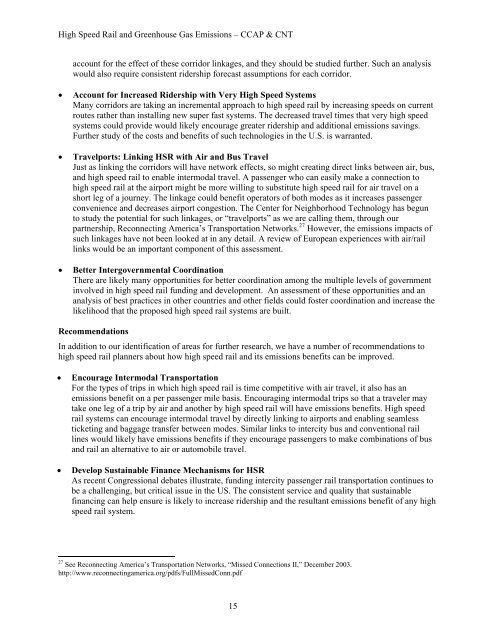High Speed Rail - Center for Neighborhood Technology
High Speed Rail - Center for Neighborhood Technology
High Speed Rail - Center for Neighborhood Technology
Create successful ePaper yourself
Turn your PDF publications into a flip-book with our unique Google optimized e-Paper software.
<strong>High</strong> <strong>Speed</strong> <strong>Rail</strong> and Greenhouse Gas Emissions – CCAP & CNT<br />
account <strong>for</strong> the effect of these corridor linkages, and they should be studied further. Such an analysis<br />
would also require consistent ridership <strong>for</strong>ecast assumptions <strong>for</strong> each corridor.<br />
• Account <strong>for</strong> Increased Ridership with Very <strong>High</strong> <strong>Speed</strong> Systems<br />
Many corridors are taking an incremental approach to high speed rail by increasing speeds on current<br />
routes rather than installing new super fast systems. The decreased travel times that very high speed<br />
systems could provide would likely encourage greater ridership and additional emissions savings.<br />
Further study of the costs and benefits of such technologies in the U.S. is warranted.<br />
• Travelports: Linking HSR with Air and Bus Travel<br />
Just as linking the corridors will have network effects, so might creating direct links between air, bus,<br />
and high speed rail to enable intermodal travel. A passenger who can easily make a connection to<br />
high speed rail at the airport might be more willing to substitute high speed rail <strong>for</strong> air travel on a<br />
short leg of a journey. The linkage could benefit operators of both modes as it increases passenger<br />
convenience and decreases airport congestion. The <strong>Center</strong> <strong>for</strong> <strong>Neighborhood</strong> <strong>Technology</strong> has begun<br />
to study the potential <strong>for</strong> such linkages, or “travelports” as we are calling them, through our<br />
partnership, Reconnecting America’s Transportation Networks. 27 However, the emissions impacts of<br />
such linkages have not been looked at in any detail. A review of European experiences with air/rail<br />
links would be an important component of this assessment.<br />
• Better Intergovernmental Coordination<br />
There are likely many opportunities <strong>for</strong> better coordination among the multiple levels of government<br />
involved in high speed rail funding and development. An assessment of these opportunities and an<br />
analysis of best practices in other countries and other fields could foster coordination and increase the<br />
likelihood that the proposed high speed rail systems are built.<br />
Recommendations<br />
In addition to our identification of areas <strong>for</strong> further research, we have a number of recommendations to<br />
high speed rail planners about how high speed rail and its emissions benefits can be improved.<br />
• Encourage Intermodal Transportation<br />
For the types of trips in which high speed rail is time competitive with air travel, it also has an<br />
emissions benefit on a per passenger mile basis. Encouraging intermodal trips so that a traveler may<br />
take one leg of a trip by air and another by high speed rail will have emissions benefits. <strong>High</strong> speed<br />
rail systems can encourage intermodal travel by directly linking to airports and enabling seamless<br />
ticketing and baggage transfer between modes. Similar links to intercity bus and conventional rail<br />
lines would likely have emissions benefits if they encourage passengers to make combinations of bus<br />
and rail an alternative to air or automobile travel.<br />
• Develop Sustainable Finance Mechanisms <strong>for</strong> HSR<br />
As recent Congressional debates illustrate, funding intercity passenger rail transportation continues to<br />
be a challenging, but critical issue in the US. The consistent service and quality that sustainable<br />
financing can help ensure is likely to increase ridership and the resultant emissions benefit of any high<br />
speed rail system.<br />
27 See Reconnecting America’s Transportation Networks, “Missed Connections II,” December 2003.<br />
http://www.reconnectingamerica.org/pdfs/FullMissedConn.pdf<br />
15



